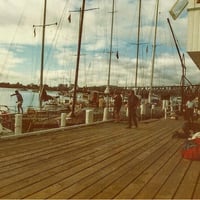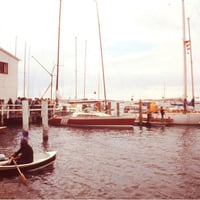Auckland to Tauranga - How it Started
`The Auckland to Tauranga Race to 1949
The Auckland to Tauranga Race was not conceived by a bunch of yachties who wanted to add some adventure to their sailing schedule. No – it was a Tauranga businessman, Colin Norris, who introduced the Auckland to Tauranga Race, giving it the title of ‘Ocean Race’ to promote the Tauranga Annual Regatta. The organising committee for the Annual Regatta was known as the Regatta Club, made up from officials from the local aquatic sports clubs. TYPBC had a strong representation within the Regatta Club.
The ‘unqualified success’ of the 1920 Annual Regatta drew the attention of Auckland yachtsmen who expressed an interest in participating in future regattas if £25 or more was offered in prize money. At the next planning meeting in mid-December, the new secretary Colin Norris suggested an Auckland to Tauranga Ocean Race that finished just before the Annual Regatta. His rationale was that Auckland yachts would compete and stay over to participate in the Regatta, with £20 prizemoney for an invitation yacht race on Regatta day. Unfortunately, this offer came too late for Auckland organisers and the race didn’t eventuate.
The Regatta Club decided in June 1921, at the suggestion of Colin Norris, to offer a handsome trophy in the form of a gold cup, to be known as the ‘One Hundred Guinea Gold Cup’, for an annual yacht race from Auckland to Tauranga. The winner held the cup for one year and would receive a miniature that would remain in their possession. For this, the Regatta Club was prepared to spend one hundred guineas ($18,000 in today’s money.)
At 1600 hours on December 24, 1921, five yachts started from Kings Wharf in Auckland for the inaugural Auckland to Tauranga Ocean Race. At 1548 hours the following day, Christmas Day as it happened, Victory crossed the finish line between a launch and North Rock on Mauao, followed by Waione, Restless, Heartease and Ngahau, just over two hours later. Waione won the One Hundred Guinea Gold Cup, as it was named, on corrected time.
And what a welcome the Auckland yachts received the following day, Boxing Day, Regatta Day. Anchored off Town Wharf, bunting fluttered on the SS Ngapuhi, the flagship for the occasion, instruments gleamed as the Municipal Brass Band taratadahtah-ed from the deck of the flagship. Visitors from Whakatane to Waihi, along with at least one hundred from Auckland that sailed down on the Ngapuhi, invaded every vantage point they could find. Queenie and Colonist, who had cruised down from Auckland just to be part of the Regatta, started with the five Auckland yachts and two from Tauranga in the invitation race around Karewa.
The following year eight yachts started in the Ocean Race. IorangI, Restless, Heartease, Moana, Ngahau, Queenie, Waione and Celox, all heavyweights in their class, Iorangi being the largest at 52 feet with eight crew members; the smallest was Celox, a twenty-six-foot Mullet Boat with a crew of five.
Each year the Auckland to Tauranga Ocean Race was held to integrate with the Annual Regatta with the One Hundred Guineas Gold Cup presented to the winner, along with a miniature. The skipper took the cup home and held it until the following race. A Champions Flag was presented to the skipper of the Line Honours yacht. Yachts were given a time handicap. The organising committee of the Annual Regatta and the Auckland to Tauranga Ocean Race was known as the Regatta Club, made up from officials from the local aquatic sports clubs. TYPBC had a strong representation within the Regatta Club.
Colin Norris was an ex-seaman, land and estate agent, JP, local coroner, and President of the Chamber of Commerce. Colin injected a level of enthusiasm into the boating fraternity not seen for some time and he was responsible for the success of the Annual Regatta in the early 1920s. As secretary of the Regatta Club, Colin wanted the Annual Regatta to be as well-known as the Melbourne Cup. Colin Norris died in August 1926, at the age of 55, and the Gold Cup was re-named the ‘Colin Norris Memorial Gold Cup’, a change popular with Auckland yachtsmen who greatly appreciated the work Colin accomplished in the interest of aquatic sport.
The race started from Kings Wharf in the late afternoon or early evening on either December 23 or 24 and finished off North Rock at the base of the Mount. Competitors considered the race as an adventure rather than an ocean race and often yachts would cruise down rather than race to participate in the Annual Regatta, which was held either on Boxing Day or the day after. Visiting yachts were usually towed by launches through the entrance and anchored off Town Wharf and the crews hosted by local members.
Fleet sizes ranged between four entries in 1929 and twenty entries, including seven Mullet Boats in 1931. A class for Centreboard yachts, IE Mullet Boats, was created in 1926 for the Clench Trophy with two entries: Awatere (26-footer) and Lorna (20-footer). Mullet Boat entries were mainly twenty-six footers with a couple of twenty-two footers. They stopped participating after 1934. Finishing times ranged between nineteen hours, twenty-eight minutes (Ngatoa in 1930), and thirty-four hours, forty minutes and twenty-eight seconds (Ngatoa in 1935). From 1925, the media were kept informed via [homing] pigeons released with progress reports tied to one of their legs from one or two of the competing yachts. Many of the yachts that competed were big names and can be found in any book about New Zealand yachting history. Until 1939, just three Tauranga yachts had participated since the inception of the Gold Cup. Charles Hartley’s Vanitie in 1927 and 1928, Percy Simmonds’ Janet in 1927, and Frank Gresham’s Ngahuia 1939.
The decline in entries from eleven in 1935 to four in 1939 concerned the Regatta Committee. The Auckland to Tauranga Ocean Race had always competed with the Auckland to Russell Ocean Race, which also started from Kings Wharf on the same day. In the 1920s, owners tended to alternate between the Auckland to Tauranga race and the Auckland to Russell race each year. In the late 1930s, The Gold Cup and the Tauranga Annual Regatta were no longer a magnet for the Auckland boats, even though the Annual Regatta continued to be as successful as ever. But then, in 1940, ten entries were received, including two from Tauranga. This may have been due to Ranger who took Line Honours in 1939 and created much interest when she anchored off Town Wharf. However, on December 24, 1940, hours before the start of the Auckland to Tauranga race, Race Control received a cable from Naval Command with the instruction to cancel the race, as the course transgressed areas they deemed ‘dangerous’. No further races were held until 1945.
One of the most influential men in New Zealand yachting at the time was Wilkie Wilkinson; small in stature, big in opinion, with a fog-horn voice. A long-time supporter of the Auckland to Tauranga Ocean Race and Annual Regatta, he used his regular column in the New Zealand Herald, under the pseudonym ‘Speedwell’, and his magazine “New Zealand Yachtsman”, to create interest and promote the race to work up entries. Since 1921 Wilkie travelled each year to Tauranga to assist in officiating at the Annual Regatta.
In October 1944, Wilkie wrote to the editor of the Bay of Plenty Times urging the Regatta Committee to consider holding the Regatta and Ocean Race now the War was over. In 1946 he presented a cup for keelboat competition at the Annual Regatta. Keelboat owners had agreed to race for a trophy rather than prize money.
The Regatta Club took heed and three yachts competed in the 1944 race, including Peri from Tauranga. There were four entries in 1945 and ’46, including Seaward and Vanitie from Tauranga. Vanitie took line honours in 1945, the first Tauranga yacht to do so. In 1947, ten yachts entered with three from Tauranga, Matutua, Seaward and Dianne, with Matutua taking line honours. No Annual Regatta was held this year due to the poliomyelitis epidemic.
Gloom permeated the 1948 Regatta Club AGM where a motion was tabled to put the Regatta Club into recess, but, for just one year. Members conceded the prospects for a regatta looked unpromising; the waterfront had been ruined, mainly from the export of timber, and support in the town had run out. Percy Carter agreed the Regatta Club had had its day and should be put to bed, and the Auckland to Tauranga Ocean Race taken over by TYPBC. Ten entries were received by TYPBC for the 1948 Ocean Race, including Mata-Atua from Tauranga. TYPBC organised a regatta a few days after, mainly for the Wilkinson Cup with races for centerboarders included.
And then on November 25, 1949, a public meeting was held, and the Regatta Club reformed. The Ocean race would start on December 24 with Boxing Day set for the Annual Regatta. The Bay of Plenty Times published the programme on Dec 23 but no further reports about the Ocean Race or the Annual regatta appeared.


